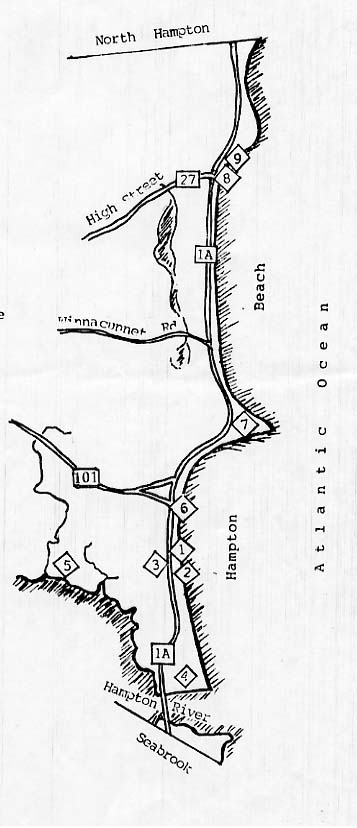By Irene Palmer
December 18, 1995

1. Hampton Beach Chamber of Commerce
2. Hampton Beach Sea Shell
3. Hampton Beach Casino
4. Hampton Beach State Park
5. Sargent’s Island
6. The N.H. Marine Memorial
7. Great Boar’s Head
8. Bicentennial Park
9. Old Fish Houses &
Ruth G. Stimson Seashore Park
When the first white settlers came in 1638, what we know as Hampton Beach was a barrier island. The sand dunes protected the upland. The area between Great Boar’s Head and Hampton River was empty and sandy. Great Boar’s Head and all the adjacent marsh which was called the Great Ox Common was used for haying and pasture for cattle. The coast was used by fishermen. Sargent’s Island (the end of Island Path) was set aside by the Town in 1656 for fishermen to salt and dry their fish on racks or “flakes.” Later there was a thriving fishing industry at North Beach. The rough pathway between Winnacunnet Road and Boar’s Head was called “The Causeway” or “The Logs.” It was customary to lay logs across a road making what was called a “corduroy road” so that wagon wheels would not get stuck. Early evidence of the recreational attraction of the area is shown by the round trips from Portsmouth of the steamboat “Tom Thumb” in 1831 and the steamboat Portsmouth in 1838. Also, a stagecoach made regular trips from Portsmouth in 1857.
The first dwelling was the Leavitt Homestead built in 1800 at North Beach. The first house at Great Boar’s Head was built in 1806 and was used as a small inn. In 1819-20 the first “resort hotel” was opened at Rocky Bend. “The Eagle House”, now the Century House, was built in 1830 and is the oldest house still standing on Boar’s Head. In the 1860s people began to build summer cottages both to the north and the south of the Head. There was rapid increase in building of cottages in the latter part of the 1800s.
1897 was an important year for Hampton Beach. The first run of the newly completed E H & A [Exeter, Hampton & Amesbury] Street Railway from Hampton to the Beach was made on July 4th that year. The street railway was expanded in the next few years to connect area cities and towns. The building of the Casino by the street railway followed in 1898. The “Big Band Era” beginning in the late 1920s attracted large crowds of people to the famous Casino Ballroom. “The landmark bandstand, also built by the street railway, stood opposite the Casino for 58 years and provided open air entertainment for many as does the Sea Shell today built in its place by the State. 1902 saw the opening of the Hampton River Bridge, also known as the “Mile-long Bridge” and the “Longest Wooden Bridge in the World.” It was replaced in 1949 by the modern bridge [Neil Underwood Memorial Bridge] that is there today.
The sand dunes which had provided protection gradually gave way to Beach development. Providing breakwaters was becoming a financial burden to the Town and these breakwaters did not prevent destruction. A severe storm in 1933 convinced people that the problems were more than the Town could cope with. Finally that year the Town deeded the beachfront to the State for the purpose of providing protection with breakwaters. In 1957 the Town built a bridge across Tide Mill Creek. To provide for the ever increasing automobile traffic, a road was built between the Town and the Beach over the bridge and was opened in 1963. It is now the easterly end of Route 101, the main access to the Beach.
Hampton Beach has always attracted crowds of people, especially on holidays and weekends. During World War II when travel was limited it was a popular destination. It remains so today. More recently people come from all parts of the United States as well as from Canada.